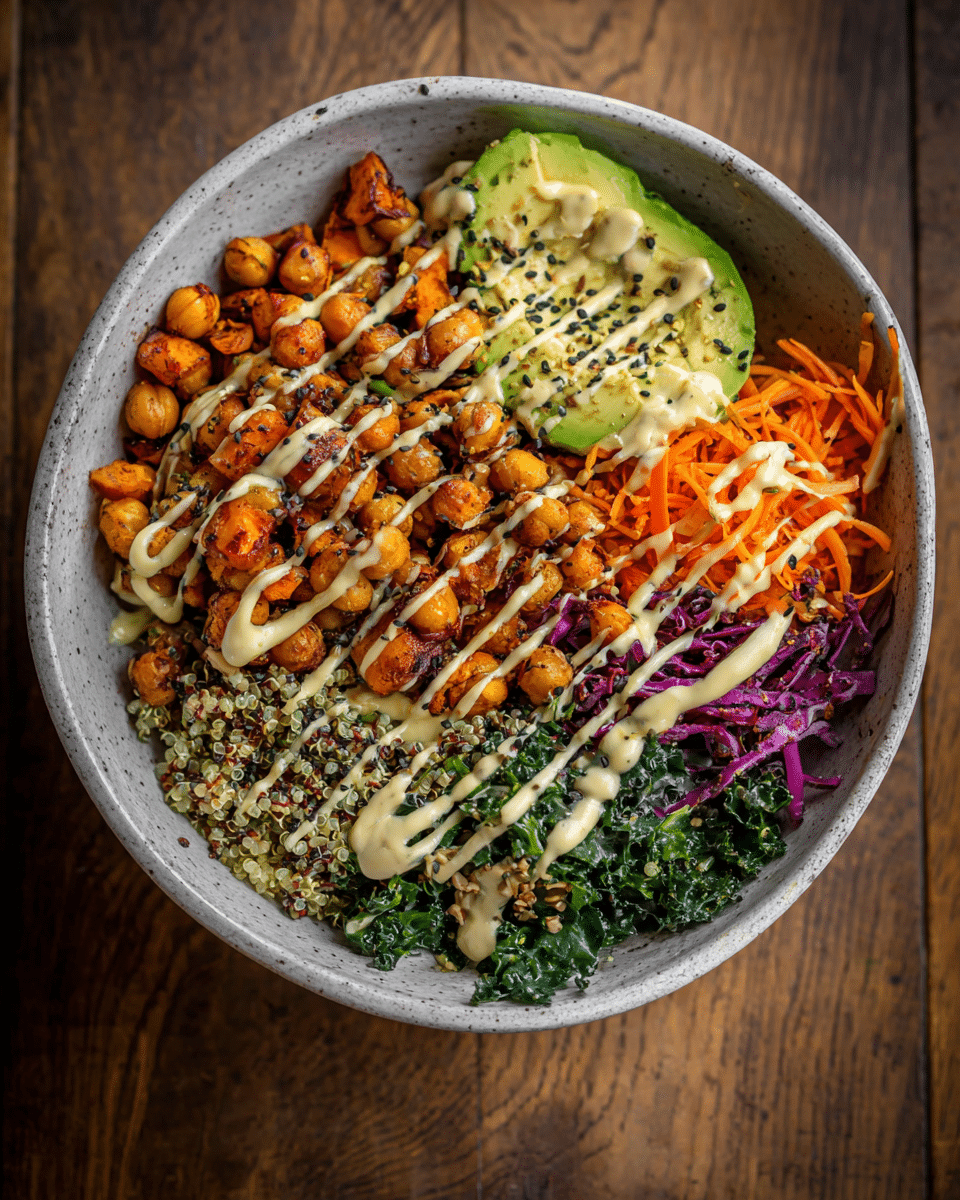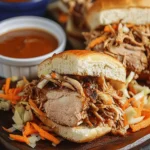This Roasted Chickpea & Kale Buddha Bowl is a vibrant, nutrient-packed meal perfect for lunch or dinner. It features crispy spiced chickpeas, tender roasted veggies, hearty quinoa, and a creamy tahini dressing—all tossed together for a fiber-rich, plant-based dish that satisfies and energizes.
FULL RECIPE
Ingredients
- 1 can (15 oz) chickpeas, drained, rinsed, and patted dry
- 1 tablespoon olive oil
- 1 teaspoon smoked paprika
- 1/2 teaspoon cumin
- Salt and pepper to taste
- 2 cups kale, chopped and massaged
- 1 small sweet potato, peeled and cubed
- 1 tablespoon olive oil (for sweet potatoes)
- 1/2 teaspoon garlic powder
- 1/2 cup cooked quinoa
- 1/4 avocado, sliced
- 2 tablespoons shredded carrots
- 1 tablespoon pumpkin seeds (pepitas)
1.For the Tahini Dressing:
- 2 tablespoons tahini
- 1 tablespoon lemon juice
- 1 teaspoon maple syrup
- 1 clove garlic, minced
- 2–3 tablespoons water to thin
- Salt to taste
Directions
- Preheat oven to 400°F (200°C). Line a baking sheet with parchment paper.
- Toss chickpeas with olive oil, smoked paprika, cumin, salt, and pepper. Spread on half of the baking sheet.
- Toss sweet potato cubes with olive oil and garlic powder. Spread on the other half of the baking sheet.
- Roast for 25–30 minutes, stirring halfway through, until chickpeas are crispy and sweet potatoes are tender.
- While roasting, massage kale with a pinch of salt to soften and reduce bitterness.
- Prepare the tahini dressing by whisking all ingredients together until smooth. Add water gradually to reach your desired consistency.
- Assemble the bowl: layer quinoa, kale, roasted chickpeas, sweet potato, carrots, avocado, and pumpkin seeds.
- Drizzle with tahini dressing before serving.
Nutrition Facts
- Calories: 420
- Protein: 13g
- Carbohydrates: 45g
- Dietary Fiber: 12g
- Sugars: 6g
- Fat: 22g
- Saturated Fat: 3g
- Sodium: 280mg
- Potassium: 870mg
- Vitamin A: 220% DV
- Vitamin C: 80% DV
- Calcium: 12% DV
- Iron: 20% DV
Health Benefits of Roasted Chickpeas
Roasted chickpeas are a fantastic source of plant-based protein and dietary fiber, making them a heart-healthy ingredient that supports digestion and helps maintain steady blood sugar levels. They are rich in essential vitamins and minerals like folate, iron, and manganese. The roasting process enhances their crunchiness without significantly reducing their nutritional value, turning them into a satisfying snack or salad topping that boosts overall nutrition.
Nutritional Value of Kale in the Bowl
Kale is often called a superfood due to its dense nutritional profile. It is loaded with antioxidants, vitamin K, vitamin C, and calcium, which contribute to bone health and immune support. Kale is also low in calories but high in fiber, aiding in digestion and promoting satiety. Including kale in this bowl adds a nutrient boost and a vibrant green color that makes the meal visually appealing.
The Role of Sweet Potatoes in the Buddha Bowl
Sweet potatoes add natural sweetness and a dose of complex carbohydrates, which provide sustained energy release. Rich in beta-carotene, sweet potatoes support eye health and have anti-inflammatory properties. Their high fiber content helps regulate blood sugar, making them a perfect balance to the protein-packed chickpeas and leafy kale, contributing to a well-rounded, nutritious bowl.
Why Quinoa is the Ideal Grain Choice
Quinoa is a complete protein, containing all nine essential amino acids, making it an excellent grain substitute for vegetarians and vegans. It is gluten-free and packed with fiber, magnesium, and iron. Quinoa’s nutty flavor and fluffy texture complement the other ingredients, providing a satisfying base that enhances the overall nutrient density of the dish.
The Importance of Healthy Fats from Avocado and Tahini
Avocado and tahini contribute heart-healthy monounsaturated fats, which help improve cholesterol levels and support brain health. Tahini, made from sesame seeds, also adds a rich, creamy texture along with calcium and antioxidants. These fats aid in the absorption of fat-soluble vitamins present in kale and sweet potatoes, making the entire bowl nutritionally balanced and delicious.
How Pumpkin Seeds Boost Nutrition and Texture
Pumpkin seeds, or pepitas, are a crunchy addition that brings extra protein, magnesium, zinc, and healthy fats to the bowl. They offer anti-inflammatory benefits and help improve heart health. Their crunch contrasts nicely with the softer textures of kale, quinoa, and roasted vegetables, elevating the eating experience with variety in every bite.
The Flavor Dynamics of Spices in Roasted Chickpeas
Spices like smoked paprika and cumin not only add depth and warmth to the chickpeas but also provide antioxidant and anti-inflammatory properties. These spices enhance the flavor without adding calories or sodium, making the bowl flavorful yet healthy. The aromatic spices contribute to a satisfying umami taste, making this meal enjoyable even for those new to plant-based eating.
Benefits of Massaging Kale for Better Texture and Digestion
Massaging kale breaks down its tough fibers, making it softer and easier to digest. This technique also reduces bitterness, allowing the natural sweetness and earthy flavor of kale to shine through. It’s a simple step that improves the overall palatability of the bowl and makes kale more appealing to those who might otherwise find it too tough or bitter.
The Role of Tahini Dressing in Enhancing Nutrient Absorption
Tahini dressing combines lemon juice, garlic, and tahini, creating a tangy and creamy dressing that complements the bowl’s textures and flavors. The healthy fats in tahini help the body absorb fat-soluble vitamins from the kale and sweet potato. Additionally, lemon juice provides vitamin C, which further aids in iron absorption from the plant-based ingredients.
How This Buddha Bowl Fits into a Balanced Diet
This Roasted Chickpea & Kale Buddha Bowl is an excellent example of a balanced meal, combining protein, healthy fats, fiber, and complex carbohydrates. It is plant-based and nutrient-dense, ideal for vegetarians, vegans, or anyone looking to add more wholesome foods to their diet. The balance of macro- and micronutrients helps promote sustained energy, weight management, and overall well-being.
Versatility and Customization Ideas
One of the great strengths of this Buddha bowl is how easily it can be customized to suit different dietary preferences and seasonal produce. You can swap kale for spinach or arugula, use other roasted vegetables like Brussels sprouts or carrots, or add protein variations such as tofu or tempeh. The tahini dressing can be adjusted in thickness or flavor by adding herbs or spices, making it highly adaptable for any taste.
Meal Prep and Convenience Benefits
This recipe is well-suited for meal prepping because the ingredients can be prepared in advance and stored separately or assembled in a bowl for grab-and-go meals. Roasted chickpeas and sweet potatoes keep well in the fridge, and kale can be massaged ahead of time to save prep on busy days. The dressing can be made in batches, making this bowl a convenient and nutritious option for weekly lunches or dinners.
Environmental Impact of Choosing Plant-Based Meals
Opting for plant-based meals like this Buddha bowl has a lower environmental footprint compared to animal-based dishes. Chickpeas and quinoa require fewer natural resources such as water and land, and growing kale has a relatively low impact on the environment. Incorporating more plant-forward meals supports sustainability goals and reduces greenhouse gas emissions linked to food production.
Conclusion
The Roasted Chickpea & Kale Buddha Bowl is more than just a colorful and tasty dish—it’s a nutrient powerhouse that supports health, sustainability, and convenience. Its balanced combination of protein, fiber, healthy fats, and vitamins makes it a perfect choice for anyone looking to nourish their body with whole, plant-based foods. Versatile, easy to prepare, and packed with flavor, this bowl can be a staple in a health-conscious lifestyle while also promoting environmental well-being.






